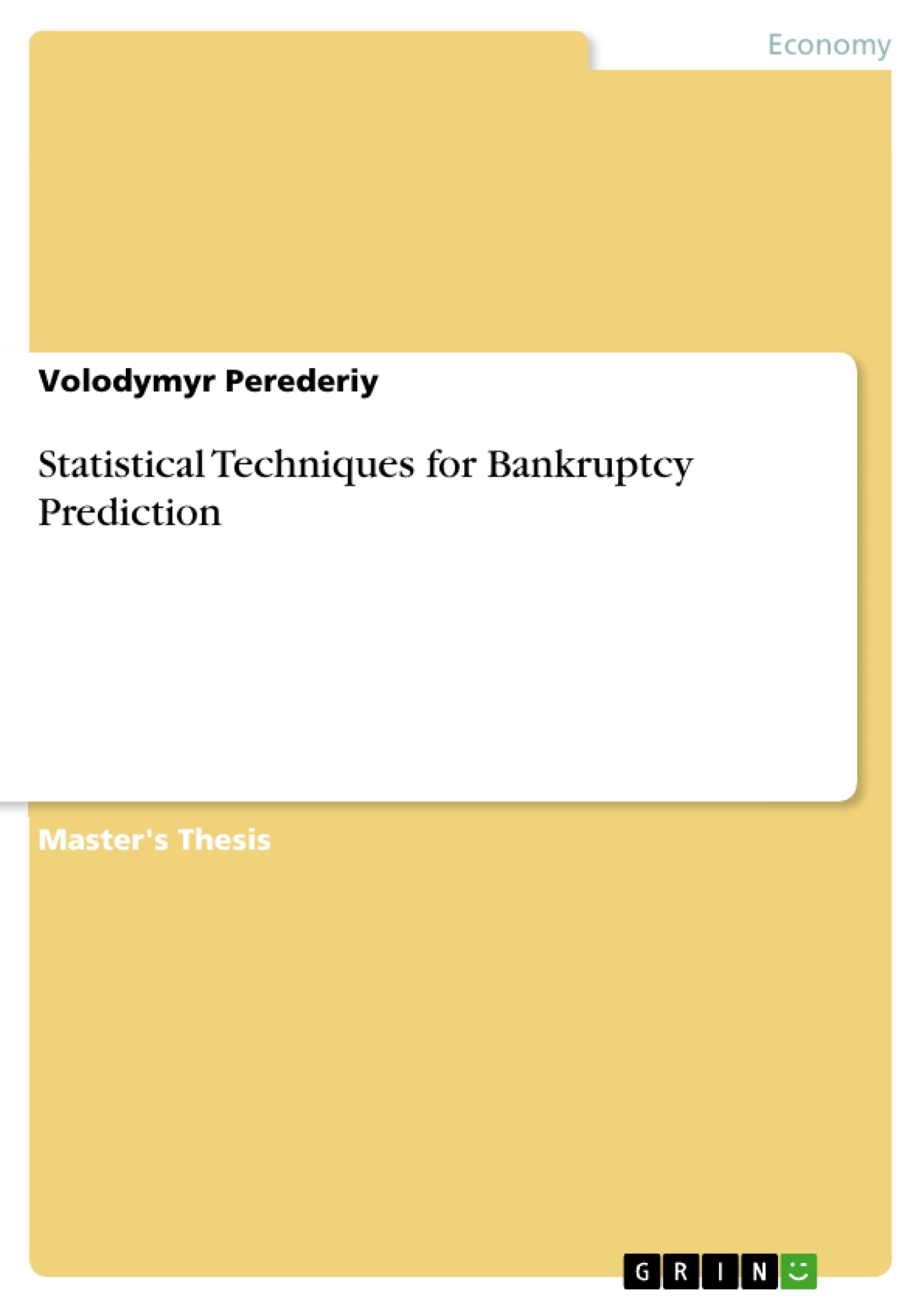Bankruptcy prediction has become during the past 3 decades a matter of ever rising academic interest and intensive research. This is due to the academic appeal of the problem, combined with its importance in practical applications. The practical
importance of bankruptcy prediction models grew recently even more, with “Basle-II” regulations, which were elaborated by Basle Committee on Banking Supervision to enhance the stability of international financial system. These regulations oblige financial institutions and banks to estimate the probability of default of their obligors.
There exist some fundamental economic theory to base bankruptcy prediction models on, but this typically relies on stock market prices of companies under consideration.
These prices are, however, only available for large public listed companies. Models for private firms are therefore empirical in their nature and have to rely on rigorous statistical analysis of all available information for such firms. In 95% of cases, this
information is limited to accounting information from the financial statements. Large databases of financial statements (e.g. Compustat in the USA) are maintained and often
available for research purposes.
Accounting information is particularly important for bankruptcy prediction models in emerging markets. This is because the capital markets in these countries are often underdeveloped and illiquid and don’t deliver sufficient stock market data, even for public/listed companies, for structural models to be applied.
The accounting information is normally summarized in so-called financial ratios. Such ratios (e.g. leverage ratio, calculated as Debt to Total Assets of a company) have a long
tradition in accounting analysis. Many of these ratios are believed to reflect the financial health of a company and to be related to the bankruptcy. However, these beliefs are often very vague (e.g. leverages above 70% might provoke a bankruptcy) and subjective. Quantitative bankruptcy prediction models objectify these beliefs in that they apply statistical techniques to the accounting data. [...]
Inhaltsverzeichnis (Table of Contents)
- Introduction
- Bankruptcy Prediction as a Classification Problem
- Bankruptcy Prediction Models
- Structural vs. Reduced Models and Explanatory Variables
- Collinearity Issues
- Sampling Considerations
- Misclassification Costs
- Measures for Model Performance
- General
- Performance Measures for Models with Probabilistic Output
- Rank Correlation Measures
- Discriminant Analysis
- Discriminant Analysis as a Classification Technique
- Bayesian Approach
- Class membership as posterior probability
- Assumption of multivariate normality
- Distributions other than multivariate normal
- Discriminant Functions Approach
- General
- Measures for importance of explanatory variables
- Testing for mean differences
- Importance and significance of discrimination functions
- Stepwise Variable Selection
- Sampling Considerations
- Misclassifications Costs
- Strengths vs. Weaknesses
- Applications for Bankruptcy Prediction
- Conditional Probability Models
- General
- Microeconomic Derivation
- Model Estimation
- Link to Discriminant Analysis
- Significance Testing
- Nested models and hypothesis testing
- Test for overall significance of logit coefficients (omnibus test)
- Wald test for linear restrictions and t-tests
- Lagrange multiplier test
- Raftery test
- Confidence intervals
- Goodness-of-Fit (GOF)
- Mean loglikelihood
- Saturated model and deviance
- Categorical independents: Pearson and Deviance GOF
- Hosmer-Lemeshow GOF test
- Box-Tidwell nonlinearity test
- Quasi-R² goodness-of-fit measures
- Variable Selection
- Sampling Considerations
- Extensions
- Interaction and quadratic terms
- Multinomial models
- Mixed logit model
- Collinearity Issues
- Misclassification Costs
- Strengths vs. Weaknesses
- Applications for Bankruptcy Prediction
- Survival Analysis
- CUSUM Charts
- Artificial Neural Networks
- Some Other Techniques
- Bankruptcy Prediction Models in Germany
- Bankruptcy Prediction in Ukraine
Zielsetzung und Themenschwerpunkte (Objectives and Key Themes)
This Master's thesis explores various statistical techniques for predicting bankruptcy. It aims to provide a comprehensive overview of different models, their strengths and weaknesses, and their applicability in predicting corporate failure.
- Analysis of different statistical techniques for bankruptcy prediction
- Evaluation of model performance and limitations
- Exploration of applications and practical implications of bankruptcy prediction models
- Comparison of models across different contexts and datasets
- Discussion of the role of data quality and sampling considerations in bankruptcy prediction
Zusammenfassung der Kapitel (Chapter Summaries)
The first chapter introduces the concept of bankruptcy prediction as a classification problem, outlining key considerations such as model types, explanatory variables, and performance measures. Chapter 2 delves into Discriminant Analysis, exploring its theoretical foundation, practical implementation, and limitations. Chapter 3 focuses on Conditional Probability Models, providing an in-depth analysis of their theoretical underpinnings, estimation methods, and significance testing. The thesis concludes with a summary and discussion of the findings, highlighting the implications for future research and practical applications.
Schlüsselwörter (Keywords)
The central focus of the thesis revolves around bankruptcy prediction, statistical techniques, classification, discriminant analysis, conditional probability models, model performance, data quality, and sampling considerations. Key models explored include logistic regression, probit models, and survival analysis. The thesis also examines the relevance of these techniques in the context of German and Ukrainian economies.
- Quote paper
- Volodymyr Perederiy (Author), 2005, Statistical Techniques for Bankruptcy Prediction, Munich, GRIN Verlag, https://www.grin.com/document/299765



